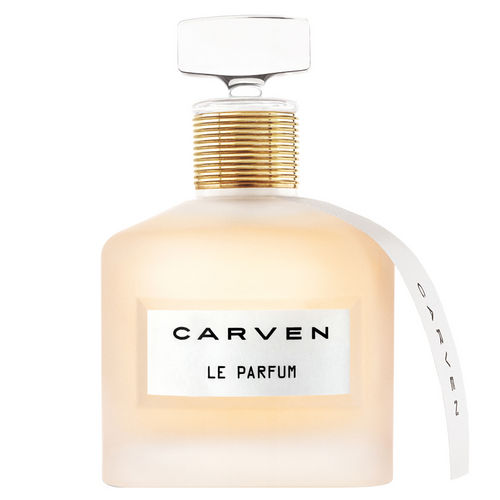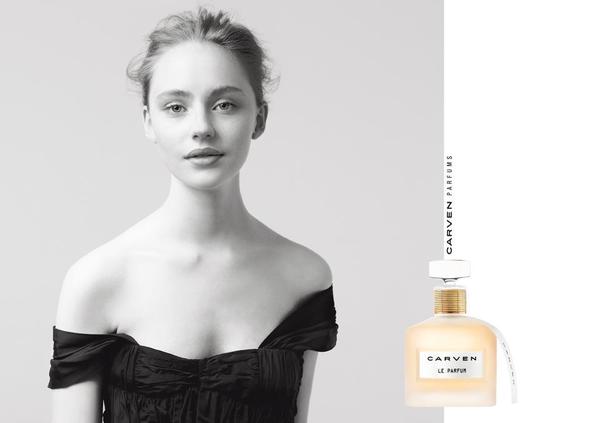Carven, Le Parfum (2013): Just An All-Around Beautiful Smell {Perfume Review & Musings} {New Fragrance}

The house of Carven founded at the end of WWII in 1945 have left their mark on the history of perfumes with such classics as Ma Griffe (1946) and Vétiver de Carven (1956), the latter which influenced a succession of great vetiver fragrances like Givenchy Vétyver (1957) and Guerlain Vétiver (1961). This spring of 2013, it's about the introduction of a new opus Carven, Le Parfum which is not an archival perfume but a new creation signed by perfumer Francis Kurkdjian. As its name indicates, it is meant to carry a new interpretation of the olfactory signature of the house, in other words it is about being Carven in perfume form for a new era. While playing subtly with the traditional olfactive heritage of the house, it is indeed a novel sillage...
Concomittantly and in a bid it seems to reinforce the visual artistic codes of the perfume house of Carven, Ma Griffe has been harmonized with the new launch as both juices now come housed in the same sparely built bottle by Thierry de Bashmakoff mimicking a lab bottle albeit chicer, a typical stylistic choice borrowed from the ethos of niche fragrance houses who wish to intimate they care more about the jus than the flacon following Baudelaire's verse turned into a dictum, "Qu'importe le flacon pourvu qu'on ait l'ivresse" At the same time, the universalist appeal of the fragrance itself hints at a typical designer perfume approach which is inclusive rather than exclusive: complexity is subtle and woven-in like a multi-variegated material rather than offered in an obvious poster, self-advertized form. This is not to say that one approach is meant to win over the other, but they are culturally distinct.
In fact, it all points to the fascinating problem of balance in perfumery which is generally underestimated, and that would be about when a sense of balance is achieved in a perfume, not in a regular sense of honest-to-God balance but in an artful and masterful sense of intangible equilibrium which takes into account many hard-to-pinpoint aspects including the experience of the perfumer and his or her intuition. In a sense it is about the chemistry that can take place between the perfumer and his or her formula where perhaps not everything is understood by the creator and later by the wearers because in a way, it is meant to be and stay elusive in contrast to some of the clear-cut formulae privileged by others.
The Personality of Carven, Le Parfum
The new artistic director for the brand since 2010 Guillaume Henry has said that what he wants to achieve with the heritage of Carven is an exercise in balance between haute couture and ready-to-wear. Namely, this translates to him as every day wearable fashion but offered with a couture twist. He's underlined that Madame Carven née Carmen de Tommaso - who is still alive at 104 years old today - started out her house from a consumer perspective and not the point of view of a stylist (although she was trained as an architect at the Ecole des Beaux-Arts in Paris) as her small height (1,55 m) made it difficult for her to find fashion that fitted her, and more than that, excited her. This pragmatic take on fashion, they feel they need to respect.
With these premises, you know that Le Parfum will have to "fit" and offer an inclusive personality if it is to be in accord with the original philosophy of the house. The first Carven perfume "Ma Griffe" was also about a signature. Aiming the youth of its time, it was never jejun. The same thing can be said of Le Parfum. What strikes you when you experience the perfume is how it takes you from a young and fresh atmosphere to a more substantial and mature one, without ever coming across as cut in the middle of an impossible proposition. Fresh, powdery, creamy and staging a rich white floral bouquet, it contains within itself several seasons of your life. You recognize your youth / spring but also your womanly years / summer. It has a retro touch all the more perceptible in the midst of a 1920s, Art-Deco Gatsby-influenced craze in the summer of 2013, but is not old fashioned. On the contrary, it succeeds in giving you the impression that you are wearing a new perfume. One of its main attributes might be that it succeeds in remaining elusive even when you can identify some threads running through it. I am tempted to say that the more I wear this perfume, the less I feel like I can pinpoint it as it reveals a wealth of facets, in turns creamy and almost tropical, at other times, green and grassy.
A Perfumed Map of the Fragrance
Initially - and this is the most commercial part of the fragrance - Carven, Le Parfum makes me think of J'Adore by Dior in its ease of character and its floral approachability. But this sensation lasts the time for it to play out possibly its hook effect meant perhaps to lure in a clientèle already used to a familiar smell. Later on, Le Parfum makes me think in its floral blooming edged with character of Fleurs de Rocaille de Caron (1933) without smelling of it. Like it, it creates the impression of an armful of fresh flowers but pre- L'Eau d'Issey and Calone. The composition is dewy without being straightforwardly transparent and aquatic. In Fleurs de Rocaille, there are notes of variegated flowers: jasmine, narcissus, rose, carnation, lily-of-the-valley, ylang-ylang, lilac, mimosa, iris which are both blended in and retaining some of their dissonances. The brand speaks of "temperament" when referring to Le Parfum and I couldn't agree more. Like Fleurs de Rocaille it is a floral with character. The fact that the ad campaign revolves around the notion of "pretty flaws" (jolis défauts) here also builds a bridge with Fleurs de Rocaille which has always come across to me as a perfume corresponding to the "jolie-laide" type. In Le Parfum, discreet peppery and opulent accents make sure the perfume is a bit dissonant. The spicy accents of sweet pea have been slightly enhanced. There is a dash of carnation.The creaminess of white florals has been creamed to a rich consistency with the custardy effect of ylang adding spice to the rose and vanilla blanc-manger. The osmanthus adds its well-known, delicate apricot-like and sueded accents. Old-school chypre bases but in minute dose remind you of long-gone perfumes. You realize that the signature of Ma Griffe is present in the base notes, but very attenuated, as if it were a filigree in a green back. Incidentally, now that we come to think of it, Kurkdjian did a project on the scent of money, banknotes in particular. What you retain at some point is that Le Parfum is a miracle of equilibrium between old and new, young and mature. Explanations about the sweet pea and the white hyacinth confirm to you that a self-conscious balance was sought out between new beginnings and plenitude.
After having smelled and lived with the perfume for some time, you also come to realize that the name of the fragrance is quite abstract, espousing the nature of the perfume well. The perfumer said he wanted to capture a certain sense of Parisian chic and life, an existence where cafés as meeting places are pivotal. The code name for the fragrance in its developing stage was actually "Trocadéro" as Kurkdjian elected that wide-open space open to the winds in Paris to be his muse (do you remember the film for Trésor by Lancôme with Isabella Rossellini?).The perfume teases the mind and senses almost non-stop. It is elusive yet present. Yes, there are floral notes, but they become almost mathematical, alluding to all, alluding to not one in particular. Beyond its remarkable sense of balance, its elusive-abstract quality, there is a sense also of amplitude that for me is a trademark quality of perfumes that are great.
Let's hope it finds its audience. This is not a perfume just for young women as the advertizing might suggest, it has that other quality found in the world of beauty, sometimes said about certain women, that they are ageless. Just a beautiful smell.
Fragrance notes: mandarin blossom, white hyancinth, sweet pea, gourmand jasmine, ylang-ylang, white sandalwood, osmanthus, and Indonesian patchouli.











Where on earth can we find this one in the states?! I want it NNNOOOOWWWW!!!!!!!!!!
I'll have to ask if and when they plan distribution in the States -- just keep asking, it can only help :) Otherwise Colette ships worldwide and you don't have to pay for French taxes when you order scents fromt them, so it balances out the costs.